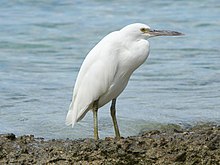Pacific reef heron
| Pacific reef heron | |
|---|---|

| |
| Dark morph | |

| |
| Light morph | |
| Scientific classification | |
| Domain: | Eukaryota |
| Kingdom: | Animalia |
| Phylum: | Chordata |
| Class: | Aves |
| Order: | Pelecaniformes |
| Family: | Ardeidae |
| Genus: | Egretta |
| Species: | E. sacra
|
| Binomial name | |
| Egretta sacra (Gmelin, 1789)
| |
The Pacific reef heron (Egretta sacra), also known as the eastern reef heron or eastern reef egret, is a species of heron found throughout southern Asia and Oceania. It occurs in two colour morphs with either slaty grey or pure white plumage. The sexes are similar in appearance.
Taxonomy
The Pacific reef heron was
Two subspecies are recognised:[6]
- E. s. sacra (Gmelin, JF, 1789) – coastal south Bangladesh and Tuamotu Archipelago(east Polynesia)
- E. s. albolineata (Gray, GR, 1859) – New Caledonia including Loyalty Islands
Description
Pacific reef herons are medium-sized herons, reaching 57 to 66 cm (22 to 26 in) in length. They have a wingspan of between 90 and 110 cm (35 and 43 in) and reach an average weight of 400 g (14 oz). The species displays an unusual, non-sexual dimorphism, with some members having entirely white plumage ('light' morph) and others (the larger portion) being charcoal-grey ('dark' morph). The reason for the colour variation or "morph", is unknown, though it is most commonly thought to be related to camouflage. The plumage of immature herons tends to be browner and duller in colour.[10]
Pacific reef herons have yellow-grey legs, and the grey variety's throats and chins are marked by a narrow, white stripe. They have brown beaks, gold-yellow coloured eyes and the surrounding areas of their faces are normally of a greenish to yellow cast.[10][11]
Distribution and habitat
The Pacific reef heron is widely distributed across southern Asia and Oceania. In Australia, Pacific reef herons inhabits most of the coastline, and offshore islands including the Torres Strait Islands.[12]
Pacific reef herons are widespread across Micronesia, with breeding records in Guam, the Marshall Islands, Northern Mariana Islands, and Palau, among various other islands.[13] The species also breeds throughout western Polynesia, including in Fiji,[9] French Polynesia,[14] and Tonga[15] – though it does not breed in Niue.[9] Surveys of the Fijian island of Rotuma, conducted in 1991 and 2018, suggest that the Pacific reef heron has recently colonized the island.[16]
New Zealand is considered to be the southern limit of the Pacific reef heron's distribution.[17] Despite being relatively uncommon, the herons are found throughout the country, though are most common in Northland.[18]
Behaviour and ecology
Breeding
The species lay clutches of eggs year-round in colonies in the jungle, between palms and mangroves or in cavities of old buildings. Two to three paled greenish-blue eggs are laid in nests constructed from branches and blossoms. Males and females share brooding tasks. They normally have a 28-day brood period. After chicks are hatched, parents provide approximately five weeks of support.[19]
Food and feeding
Their food sources are made up predominantly of varieties of ocean-based
Conservation status
In New Zealand, the Pacific reef heron has the conservation status of "Nationally endangered". It has been classified as "Regionally Critical" in the
Gallery
-
Dark morph
-
Mooloolaba, Australia
-
Juvenile dark morph, Coral Bay, Western Australia
References
- . Retrieved 12 November 2021.
- ^ Gmelin, Johann Friedrich (1789). Systema naturae per regna tria naturae : secundum classes, ordines, genera, species, cum characteribus, differentiis, synonymis, locis (in Latin). Vol. 1, Part 2 (13th ed.). Lipsiae [Leipzig]: Georg. Emanuel. Beer. pp. 640–641.
- ^ Latham, John (1785). A General Synopsis of Birds. Vol. 3, Part 1. London: Printed for Leigh and Sotheby. pp. 92–93, No. 62.
- ^ Mayr, Ernst; Cottrell, G. William, eds. (1979). Check-List of Birds of the World. Vol. 1 (2nd ed.). Cambridge, Massachusetts: Museum of Comparative Zoology. p. 215.
- ^ Forster, T. (1817). A Synoptical Catalogue of British Birds; intended to identify the species mentioned by different names in several catalogues already extant. Forming a book of reference to Observations on British ornithology. London: Nichols, son, and Bentley. p. 59.
- ^ Rasmussen, Pamela, eds. (August 2022). "Ibis, spoonbills, herons, Hamerkop, Shoebill, pelicans". IOC World Bird List Version 12.2. International Ornithologists' Union. Retrieved 28 November 2022.
- ISBN 978-1-4081-2501-4.
- ISBN 9780143567899.
- ^ a b c Watling, Dick (2001). A guide to the birds of Fiji & Western Polynesia. Suva, Fiji: Environmental Consultants Fiji. p. 99.
- ^ a b Edgar, A. T. (1978). "The reef heron (Egretta sacra) in New Zealand" (PDF). Notornis. 25 (1): 25–58.
- ISBN 978-0-19-553068-1.
- S2CID 73537024.
- ^ Wiles, Gary J. (2005). "A checklist of the birds and mammals of Micronesia". Micronesia. 38 (1): 149–189.
- ^ Beaune, David; Ghestemme, Thomas; Raust, Philippe; Blanvillain, Caroline (2018). "Herons of French Polynesia: threats, status and conservation" (PDF). Journal of Heron Biology and Conservation. 3. Retrieved 30 January 2020.
- PMID 11607357.
- ^ Cibois, Alice; Thibault, Jean-Claude; Watling, Dick (2019). "Birds and bats of Rotuma, Fiji" (PDF). Notornis. 66 (3): 139–149.
- ^ Bell, Mike (2010). "A census of reef herons (Ardea sacra) in the Marlborough Sounds" (PDF). Notornis. 57 (3): 152–155.
- ^ Chambers, Stuart (2009). Birds of New Zealand: locality guide (PDF) (3rd ed.). Orewa, New Zealand: Arun Books. p. 91.
- ^ a b "Reef heron Egretta sacra". New Zealand Birds Online. Retrieved 29 May 2021.
- ^ McArthur, Nikki; Ray, Samantha; Crowe, Patrick; Bell, Mike (August 2019). A baseline survey of the indigenous bird values of the Wellington region coastline (PDF) (Report). p. 19.




